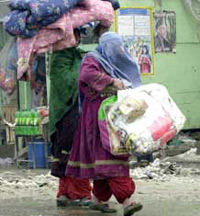UN refugee report
Three million more flee conflict in 2007
Article published on the 2008-06-17 Latest update 2008-06-17 11:58 TU
Refugee numbers increased notably in the Middle East and North Africa, while they actually went down slightly in sub-Saharan Africa, due to repatriation projects in post-conflict zones, notably Sudan, the Democratic Republic of Congo, Liberia and Burundi.
Out of a total of 11.4 million refugees under the UNHCR's responsibility, 3.1 million come from Iraq and 2.7 million from Afghanistan. Yet these numbers do not include the world’s largest population of refugees: the 4.6 million Palestinians who are under the mandate of a separate UN agency.
The report also dismisses the idea that refugees are flooding into the industrialised west. Between 83 and 90 per cent of refugees flee to neighbouring countries and stay in their region of origin.
This is reflected in some of the most striking statistics: it’s not a European country that welcomes the largest number of refugees; that honour is reserved for Pakistan, which currently hosts an estimated two million refugees, mostly from Afghanistan. Syria isn’t far behind with an estimated 1.5 million refugees, all from Iraq.
The country that produces the largest number of refugees is Afghanistan, followed closely by Iraq.
But the report notes that officially-recognised refugees, as they are defined in international law, make up only part of the story.
The majority of people who are forced from their homes remain in their home countries and are considered Internally Displaced People (IDPs). These people vastly outnumber refugees, whom international agreements define as having fled to a foreign country.
There are an estimated 51 million IDPs in the world, divided equally between those displaced due to conflict and due to natural disasters.
However, these numbers are difficult to verify as the process for counting IDPs varies greatly between countries and is not as strict in its definitions as international refugee conventions.








